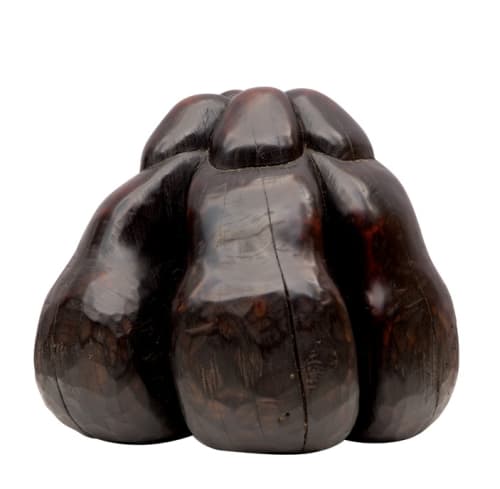SEPTEMBER 2008 HONG KONG–Wang Keping is one of China’s most important artists having been one of the represented figures of the acclaimed 1979 Stars Exhibition (Xing Xing) that opened the doors for artistic freedom throughout China and signified the beginning of Chinese contemporary art. Living in France since 1984, Wang Keping for the first time has come back to show his wooden sculptures in a museum in China for a momentous exhibition at the He Xiangning Art Museum, one of China’s most active national art museums located in Shenzhen. This exhibition is part of a series of solo exhibitions organized by the He Xiangning Art Museum, beginning with Huang Rui’s exhibition in 2007. These solo shows aim to improve the understanding of the history of Chinese Contemporary Art. The exhibition will include a total of 43 pieces of works from 1979 until 2006 as well as large bronze works. Wang Keping’s solo show will run from Oct 25th until Nov 23rd, 2008.
Born in 1949, Wang Keping started sculpting in 1978 when he noticed his friend selling paintings to buy music players and cassettes. His first sculpture made from a found piece of wood, the rung of a chair, beheld the face of a tortured man with an outstretched arm holding a little red book. This sculpture, now in the Fukuoka Museum in Japan was the start of a passionate career of China’s most blatantly honest contemporary sculptors.
Self taught, Wang Keping is driven by the beauty of simple forms. With Taoist philosophies Keping sees his work as a collaboration between himself, nature and the wood before him. He works in a way that let the wood speak. He allows the ideas that he initially has to change with the nature of the wood. “The wood can be hard or soft and I follow the will of the wood to let it tell me the direction it wants me to go,” he says. The knots, humps and grains with sinuosity form curves of a waist, a knot in the hair, a mouth screaming. Using hard woods from France such as maple, walnut, wild cherry, oak and others each type of wood has its own character and his in depth understanding and feeling allow him to take the form into another dimension through the grains that flow like hair with oak or the smooth bronze finish that is given by maple.
It is in the words of leading Chinese art scholar, Michael Sullivan that Wang Keping is best described, “It is seldom nowadays that a work of contemporary art can be understood or appreciated without a good deal of explanation by the artist and commentary by the critics. That is, in fact, the weakness of much so-called Conceptual Art. It cannot speak for itself, because the meaning is in the “idea”–and ideas are easy to come by–and not in the form. So it is a profound relief to turn to the work of Wang Keping. He likes to talk about his work, to share his thoughts with others, for that is part of his generous nature. But in fact his work needs no explanation; still less does it need theoretical analysis. If ever form spoke directly to the eye of the viewer, it is here.”
Wang Keping is one of the most recognized Chinese sculptors in Contemporary art history and is included in most historical texts. He moved to France in 1984 where he continues to live and work. His works have been exhibited in the Centre Georges Pompidou in Paris, The Musée Maillol in Paris, and The Groningen Museum in the Netherlands and now for the first time in China since 1984 at the He Xiangning Art Museum in China.
October 25 - November 23, 2008
Venue: He Xiangning Art Museum, Halls 7 & 8, Overseas Chinese Town, Nanshan District, Shenzhen, China
www.hxnart.com


